Cycling Base Training: Why and How to Build Your Aerobic Base

You can build a strong aerobic base for cycling, in a time-efficient and effective manner, with a structured base training plan. Here’s why base training and aerobic fitness are essential for every cyclist and how you can make sure you’re building your base properly for your season and goals.
What is Base Training for Cyclists?
The start of a new cycling season usually means the start of base training. Base training for cyclists is an important part of training because it brings specific physiological adaptations, which provide a foundation for further training.
Cycling base training is typically completed within a particular time of a training plan called the Base Phase. The base phase is made up of workouts designed to develop and strengthen your aerobic energy system. Building your aerobic base at the start of your season doesn’t just create a strong foundation; it also sets you up for harder and more intense workouts later on.
Cycling base training typically takes between six and twelve weeks and starts at the very beginning of a training season—well before your goal events. Because base training builds the endurance and fitness necessary for the subsequent training phases, it’s a vital part of your training progression.
Why Building an Aerobic Base is Important for Cyclists
Cycling is an endurance-based sport. Even athletes who identify as sprinters or prefer short distanced events are primarily reliant on their endurance capabilities. The aerobic energy system is the primary energy source during any type of sustained effort, which is why base training is primarily concerned with increasing aerobic capacity and muscular endurance.
Essentially, base training for cyclists is all about increasing the amount of work your muscles can accomplish using oxygen without a contribution from the anaerobic energy system. This is brought by specific physiological adaptations that include increased capillarization, mitochondrial function, fat metabolism, and cardiac output.
These adaptations combine to achieve a shared outcome, which is more oxygen extraction at the muscle. The more O2 the muscle can utilize, the more work it can do–aerobically–and generate only water and CO2 as waste products.
Adaptive Training
Get the right workout, every time with training that adapts to you.
Check Out TrainerRoadYou can think of aerobic base fitness as the foundation of a pyramid. A strong and big base supports an even higher peak. Further, the specialized fitness you’ll work on closer to your primary event or goal depends on the aerobic fitness you build at the start of the season. Introducing specialized intensity before building your base fitness can result in a plateau in fitness or a premature peak. But building a strong foundation before you build your event-specific power will allow you to reach an even higher peak and at just the right time.
How to Build Your Aerobic Base
To build your aerobic base, you’ll need to complete a structured training plan with workouts specifically targeted towards challenging your aerobic energy system. Properly structured base training will have endurance-based workouts designed to gradually challenge your aerobic abilities and progressively increase your ability to hold sustained power.
To achieve these goals, TrainerRoad offers two different methods of base training for cyclists: Sweet Spot Base and Traditional Base. Which base training plan you should choose will largely depend on the time you have available to train and your experience. Here’s the main difference between the two training phases and knowing which one is right for you.
Sweet Spot Base Training for Cyclists
Sweet Spot Base is the cycling base training plan we recommend to the majority of athletes. Sweet Spot training uses workouts that target a specific training zone to train your aerobic system. As the name implies, the Sweet Spot zone is a narrow power zone between tempo and threshold. This type of base training allows for greater productivity than Tempo riding, but with less incurred fatigue than with Threshold workouts. It essentially allows athletes to efficiently target their aerobic base fitness in less time when compared to traditional base training.
Targeting the Sweet Spot zone, instead of the endurance zone, offers a more time-efficient way to target the aerobic energy system without the need for endless hours on the bike. Sweet Spot is one of the most efficient ways to go about cycling base training, making it the ideal approach to base for most athletes.

Traditional Base Training for Cyclists
Traditional Base takes the conventional approach to base training—low intensity for long hours. Our traditional base training plan consists of workouts between 90 and 180 minutes with intervals, primarily in the Endurance and Tempo zone. These workouts are longer than the sweet spot base workouts and at a lower intensity and ultimately require a significant time commitment (upwards of 20 hours a week).
We generally only recommend the traditional base phase to a small sub-set of athletes. In particular, athletes who have a lot of time they can and want to dedicate to training. If you don’t have ten plus hours to commit to training each week, you’ll get much more out of the Sweet Spot approach.

Base Training for Cyclists: Dos and Don’ts
- Do: Complete 6-12 weeks of base training.
- Don’t: Skip base training.
- Do: Focus on consistency.
- Don’t: Attempt more training volume than you can handle.
- Do: Add in Strength Training.
- Don’t: Avoid fueling your workouts.
How to Plan Your Base Training
With this information in mind, you can begin planning your base training. Planning out your season is easy to do. All you need is your schedule and your goal events, or if you’re not racing, your training goals. With this information, you can use Plan Builder to plan your cycling base training plan.
Where to Start
The best part about base training for cycling is that you need absolutely no prior fitness or established strength to get started and be productive. You can begin base training at any time with any level of fitness. With that being said, if you have upcoming goals, you’ll want to plan your base training ahead of time to make sure you get everything done in time to peak for your event.
Because it takes between two to three months to complete a base training plan and four more months to complete Build and Specialty, if possible, you’ll want to start a cycling base training plan seven months before your priority event. With that said, if you have more or less than seven months to train, it’s no problem. Plan Builder will add or subtract weeks of training to your plan to fit everything in, and base training is likely to be included in that progression regardless of the time frame.
If you don’t have any events on your calendar and you’re training just to get faster, you can start base training whenever you reach a natural starting point. After the off-season, vacation, or time off can be a good time to jump into base training. With that said, if you have any tangible goals, like a particular ride you want to achieve, and you want to tie it to a date, consider starting to build your aerobic base well in advance of those goals. That way, you can complete an entire Base, Build, and Specialty progression.
How Long Should I be Doing Base Training?
It takes time to build a broad aerobic base. Ideally, you’ll complete at least twelve weeks of base training at the start of each season. Twelve weeks gives you just enough time to complete both phases of a Sweet Spot Base plan or all three phases of a Traditional Base plan.
If you don’t have enough time to do a full Base, Build, and Specialty progression before your event, you’ll still want to complete as much of the twelve weeks as possible. Depending on your time constraints, this might mean that you do a full twelve weeks in Base, and cut out a few weeks from your Build and Specialty phases. Or, if you have more experience with training and intervals, you may be able to do just six weeks of Base and then start Build and Specialty.
That’s not to say twelve weeks is the cap on the benefits of base training for cyclists. If you have more than twenty-eight weeks until your goal event, you can also benefit from adding an additional Base phase, after your first Build phase. Doing an additional phase of Base later in the season will reinforce your aerobic fitness and endurance at a heightened level of fitness.
How Many Hours per Week Should I Train During Base?
How much cycling base training you should be doing each week depends on how much time you have available to train and how much training stress you can productively handle. To address your individual needs, you have three different options — low-volume, mid-volume, high-volume.
If you can dedicate yourself to three structured workouts per week, a low-volume approach is the best fit. With a low-volume base training plan, you’ll be spending between three and a half hours and four and a half hours base training each week.
If you can handle a bit more training stress and have a bit more time, then a mid-volume plan with five workouts each week will be the best approach. If you opt for a mid-volume plan, you will start base training with between five and six hours of training each week.
If you have multiple years of structured training experience and a consistent daily window to train, then you may be in a position to take a high-volume approach. A high-volume base plan will have you doing six structure workouts per week with a minimal time dedication of nine hours and at most ten or eleven.
Cycling Base Training Plan Example
The easiest way to plan your base training, and ensure that you’re doing the right amount of work, is with a structured base training plan. A structured base training plan begins with an FTP assessment. It progresses from there with workouts that target your aerobic fitness, muscular endurance, as well as your ability to handle a high level of work. For an idea of what this might look like, here’s the first week from our mid-volume Sweet Spot Base I training plan.
Sweet Spot Base I

Week one of the Mid-Volume Sweet Spot Base training plan begins with a Ramp Test. You’ll take a Ramp Test at the start of each new training phase to assess your fitness and keep your workouts tailored to your fitness.
Ramp Test: FTP Assessment
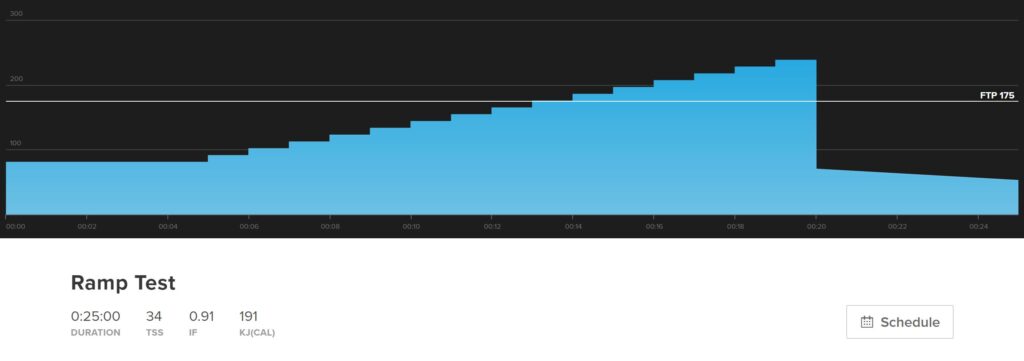
Taku: Endurance
After the Ramp Test, you’ll complete an Endurance workout called Taku for some active recovery. Taku is a thirty-minute aerobic endurance workout between sixty and seventy percent of your FTP. Endurance workouts like these aim to improve your aerobic power production capabilities in a steady, low-stress manner. Over time, Endurace workouts like these can productively increase fat metabolization and muscular endurance—both vital in base training for cyclists.
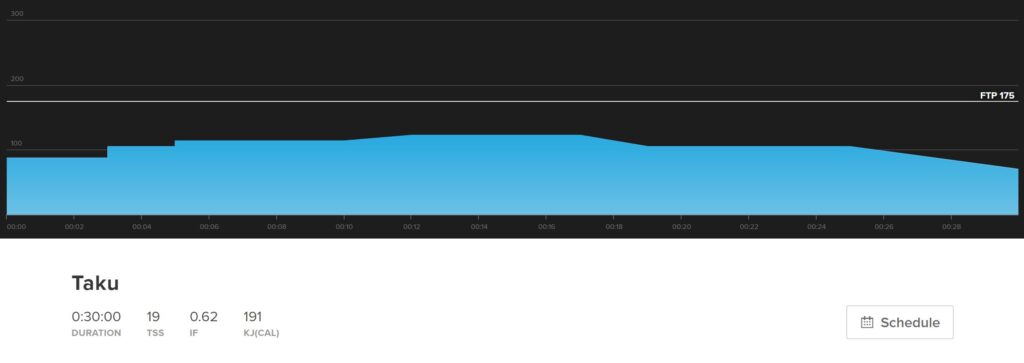
Mount Field: Sweet Spot
On the third day of your cycling base training plan, you’ll have your first interval workout. Mount Field is technically a Tempo workout, but it serves as an introduction to Sweet Spot training, with three twelve-minute intervals at eighty-five percent of your FTP. This type of base training is designed to improve your ability to resist fatigue at reasonably high power outputs over substantial lengths of time. Additionally, base training provides cyclists an opportunity to target specific aspects of climbing form, aero positioning, and cadence. This workout includes guided drills aimed at just that.
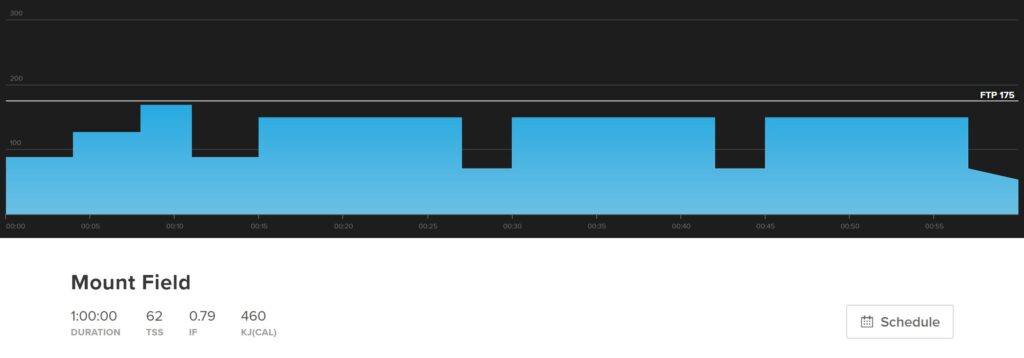
Reinstein: “Over-Unders”
The primary objective of an over-under workout like Reinstein is to develop your ability to handle changes in pace while maintaining a high level of work. The sections that are above FTP flood the muscle with metabolic byproducts, while the valleys effectively train your body to process lactate. These types of workouts are an excellent addition to a cycling base training plan. Of course, these workouts may require a bit more recovery than an Endurance one.
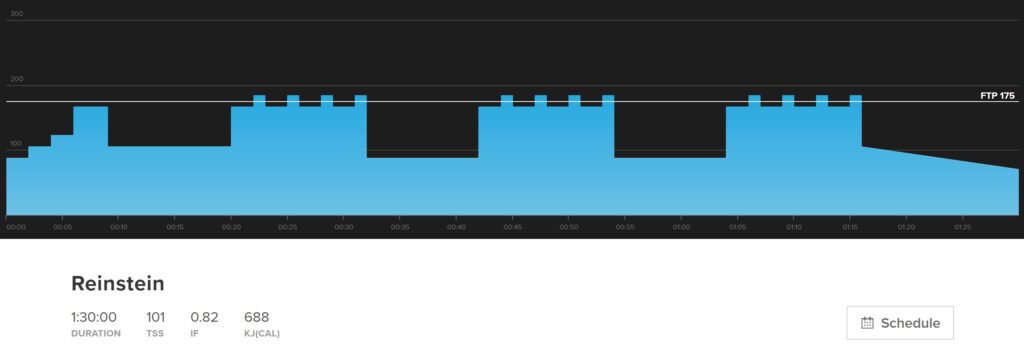
Glassy: Sweet Spot
The final workout in the first week of this cycling base training plan is Glassy—a four-by fifteen-minute Sweet Spot workout. These Sweet Spot intervals aim to increase aerobic capabilities via reasonably long, mildly more intense work than your typical long-duration, minimally-changing aerobic endurance workouts. The workloads are still low enough that you can spend a lot of time at this intensity without requiring disproportionately long recovery periods like you might face when attempting high amounts of work performed closer to your FTP.
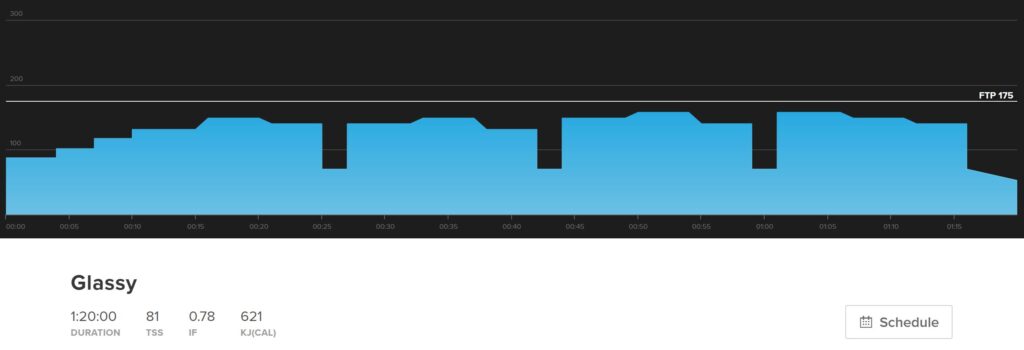
From here, the sweet spot base plan continues to develop these different capabilities, by incrementally increasing the challenge of the workouts with additional intensity, variety, and duration. After five weeks of this cycling base training plan, you’ll recover and reap all the benefits of your hard work with a recovery week. After that, you’ll start another base training block with a Ramp Test, starting Phase II of the Sweet Spot Base plan.
How to Maintain Aerobic Base for Cycling
Whether it’s the offseason or you just need a break, it’s fairly easy to maintain your cycling base fitness. The longer you’ve been training, the slower you’ll lose your aerobic base. It takes about 25-35 days before you see a decline. The best news is that you don’t have to do much to touch up your base. Over your break, do an endurance workout every 10-14 days. A 90-minute trainer workout like Baxter or a 2-3 hour outside ride is enough. This endurance work doesn’t have to be on the bike. You could run, hike, or go for a swim. It just needs to be something that stimulates your aerobic system.
An alternative way to maintain your aerobic base during the off-season is with TrainNow. TrainNow uses Adaptive Training’s machine learning-based insights to recommend workouts suited for your current abilities. You can select from three different types of workouts—Endurance, Climbing, or Attacking. If you just want to touch up your base, we’d recommend selecting an Endurance or Climbing one.
Plan Builder
Not sure where to start? You can use Plan Builder to make scheduling and planning as easy as possible. Just enter your goal events, your availability to train, and your current experience with interval training. When all is said and done, you’ll have a cycling base training plan all laid out, and a training plan that will look something like this:
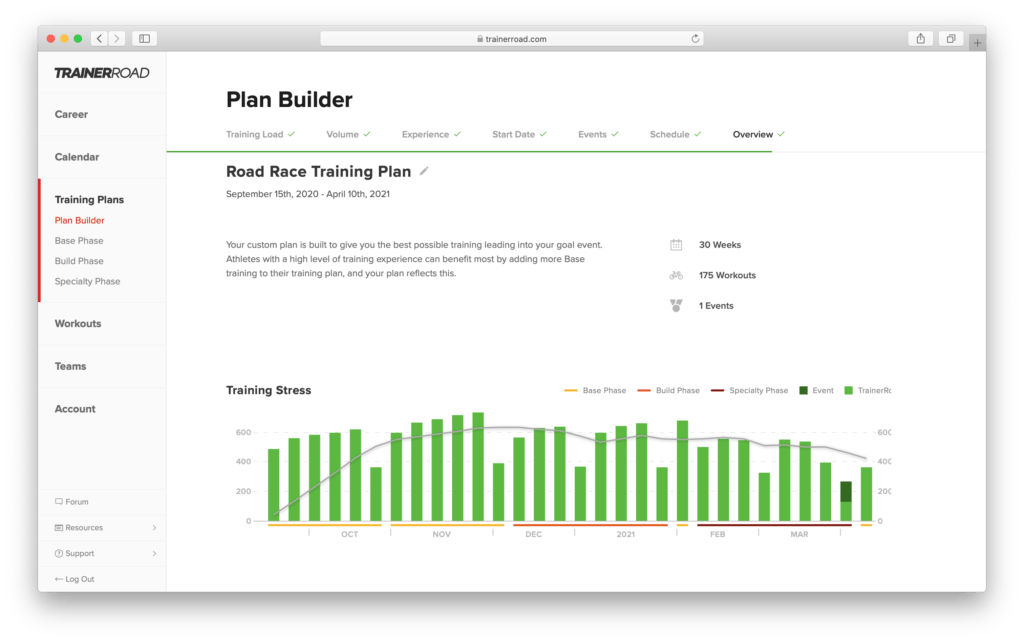
TrainNow
Not ready to start a training plan? TrainNow gives you the flexibility to complete structured training with intelligently recommended workouts when and how you want. It is the easiest way to get the benefits of structured workouts when you’re not following a training plan, or when you want to supplement what you already have on the calendar. You can start your base training for cycling with TrainNow and take advantage of power-based interval training.
More on Base Training
For more cycling training knowledge, listen to Ask a Cycling Coach — the only podcast dedicated to making you a faster cyclist. New episodes are released weekly.